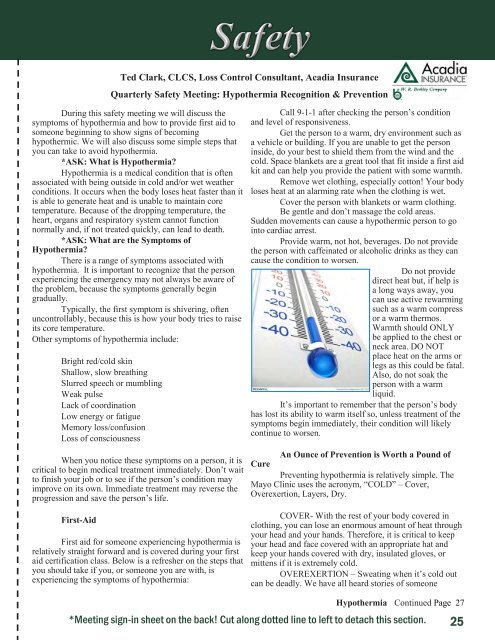PLC Logger's Voice Winter 2019
Create successful ePaper yourself
Turn your PDF publications into a flip-book with our unique Google optimized e-Paper software.
Ted Clark, CLCS, Loss Control Consultant, Acadia Insurance<br />
Quarterly Safety Meeting: Hypothermia Recognition & Prevention<br />
During this safety meeting we will discuss the<br />
symptoms of hypothermia and how to provide first aid to<br />
someone beginning to show signs of becoming<br />
hypothermic. We will also discuss some simple steps that<br />
you can take to avoid hypothermia.<br />
*ASK: What is Hypothermia?<br />
Hypothermia is a medical condition that is often<br />
associated with being outside in cold and/or wet weather<br />
conditions. It occurs when the body loses heat faster than it<br />
is able to generate heat and is unable to maintain core<br />
temperature. Because of the dropping temperature, the<br />
heart, organs and respiratory system cannot function<br />
normally and, if not treated quickly, can lead to death.<br />
*ASK: What are the Symptoms of<br />
Hypothermia?<br />
There is a range of symptoms associated with<br />
hypothermia. It is important to recognize that the person<br />
experiencing the emergency may not always be aware of<br />
the problem, because the symptoms generally begin<br />
gradually.<br />
Typically, the first symptom is shivering, often<br />
uncontrollably, because this is how your body tries to raise<br />
its core temperature.<br />
Other symptoms of hypothermia include:<br />
Bright red/cold skin<br />
Shallow, slow breathing<br />
Slurred speech or mumbling<br />
Weak pulse<br />
Lack of coordination<br />
Low energy or fatigue<br />
Memory loss/confusion<br />
Loss of consciousness<br />
When you notice these symptoms on a person, it is<br />
critical to begin medical treatment immediately. Don’t wait<br />
to finish your job or to see if the person’s condition may<br />
improve on its own. Immediate treatment may reverse the<br />
progression and save the person’s life.<br />
First-Aid<br />
First aid for someone experiencing hypothermia is<br />
relatively straight forward and is covered during your first<br />
aid certification class. Below is a refresher on the steps that<br />
you should take if you, or someone you are with, is<br />
experiencing the symptoms of hypothermia:<br />
Call 9-1-1 after checking the person’s condition<br />
and level of responsiveness.<br />
Get the person to a warm, dry environment such as<br />
a vehicle or building. If you are unable to get the person<br />
inside, do your best to shield them from the wind and the<br />
cold. Space blankets are a great tool that fit inside a first aid<br />
kit and can help you provide the patient with some warmth.<br />
Remove wet clothing, especially cotton! Your body<br />
loses heat at an alarming rate when the clothing is wet.<br />
Cover the person with blankets or warm clothing.<br />
Be gentle and don’t massage the cold areas.<br />
Sudden movements can cause a hypothermic person to go<br />
into cardiac arrest.<br />
Provide warm, not hot, beverages. Do not provide<br />
the person with caffeinated or alcoholic drinks as they can<br />
cause the condition to worsen.<br />
Do not provide<br />
direct heat but, if help is<br />
a long ways away, you<br />
can use active rewarming<br />
such as a warm compress<br />
or a warm thermos.<br />
Warmth should ONLY<br />
be applied to the chest or<br />
neck area. DO NOT<br />
place heat on the arms or<br />
legs as this could be fatal.<br />
Also, do not soak the<br />
person with a warm<br />
liquid.<br />
It’s important to remember that the person’s body<br />
has lost its ability to warm itself so, unless treatment of the<br />
symptoms begin immediately, their condition will likely<br />
continue to worsen.<br />
An Ounce of Prevention is Worth a Pound of<br />
Cure<br />
Preventing hypothermia is relatively simple. The<br />
Mayo Clinic uses the acronym, “COLD” – Cover,<br />
Overexertion, Layers, Dry.<br />
COVER- With the rest of your body covered in<br />
clothing, you can lose an enormous amount of heat through<br />
your head and your hands. Therefore, it is critical to keep<br />
your head and face covered with an appropriate hat and<br />
keep your hands covered with dry, insulated gloves, or<br />
mittens if it is extremely cold.<br />
OVEREXERTION – Sweating when it’s cold out<br />
can be deadly. We have all heard stories of someone<br />
Hypothermia Continued Page 27<br />
*Meeting sign-in sheet on the back! Cut along dotted line to left to detach this section. 25


















